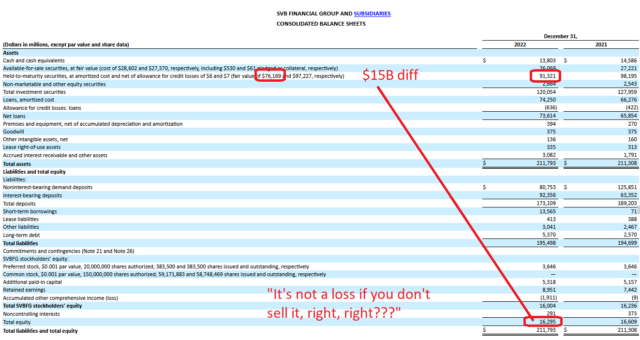Silvergate (NYSE: SI) and Silicon Valley Bank (Nasdaq: SIVB) have both suffered immense market value losses this week.
In the case of SIVB, the story is fairly simple – they had a huge duration mismatch between their (asset) held-to-maturity portfolio and (liability) short-term deposits.
Held-to-maturity assets are held on the balance sheet at cost value, while fair (market) value is indicated.
SIVB had a differential of $15.2 billion between the stated book value and the fair market value of such securities, while the total equity of the firm was $16.3 billion.
Assuming they liquidated everything at once, the entity as a whole would be worthless.
One other problem they had was that their source of capital (zero-interest bearing deposits) was getting pulled out very rapidly and the only thing they could replace them with was high-interest deposits.
It eventually crashed this week – going from $275 per share to what will effectively be a zero. The unsecured debt is trading around 40 cents on the dollar, but it remains to be seen whether there will be any recovery there.
This was a classic bank run, coupled with financial mismanagement by the bank – when the asset duration and liability duration are mismatched, and when your depositors decide they want their money now, if you can’t raise the short-term funds to pay the depositors, you’re forced to sell those held-to-maturity securities and that is when your capital adequacy ratios goes into the toilet – and the FDIC steps in.
The media will make this out to be a crypto/digital-currency related issue, but that was only part of the story (how the bank got all of these short-term non-interest bearing deposits in the first place). The stronger part of the story is mismanagement of the duration risk.
There will be some collateral damage here, but unlike Lehman (which was a much larger entity) I suspect this will be somewhat more contained, although will cause volatility ripples in the next couple weeks in the financial sector as financial institutions shore up their solvency/liquidity books. It is a warning shot across the bow of every institution out there – liquidity is golden.

Great moment to load up those bond-like Canadian top 5 🙂
Not my first instinct…..
I agree. SVB management were pretty dumb. They put half of their deposits into a 10yr duration bond portfolio at 1.5% yields, when their deposits were concentrated in sketchy cash-incinerating Silicon Valley start-ups. This isn’t 2008. The CEO and CFO should go back to school.
The question is does this create a contagion to other regional banks? The Canadian banks have been big purchasers of US regional over the last decade. Sacha, do you see added risk to the cdn banks? Do you believe these are the first cracks in many due to the rapid rise in rates? One thing I noticed, with the exception of the oil and gas sector, was the amount of debt due in 2025-2027 by various companies. I was expecting some fireworks 2nd half of 24′ when they restructured but maybe this SVB fiasco changes the timing. Thanks for your posts.
Customers are getting bailed out so there’s no incentive to further bank runs. US has new program that lends at par against collateral like US agency debt, govt debt, etc. That would prevents them from having to take mark-to-market loss. One can argue crisis averted.
I think about the ratings agencies in this situation. It seems that the whole thing began to unravel when Moody’s threatened a downgrade last week. So good for them for flagging the issue, but should they have done so earlier? The graphic you posted Sacha showed problems hiding in plain sight, stewing for months. On the other hand, there’s a dilemma the agencies face, clearly, a negative review can have huge consequences on financial institutions (and more importantly, systemic repercussions).